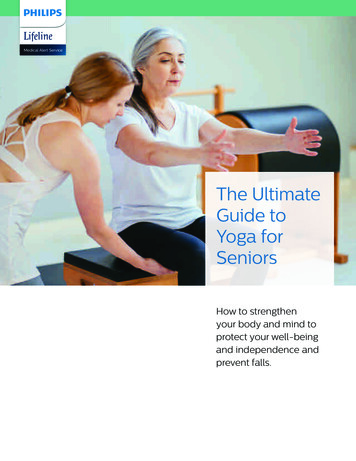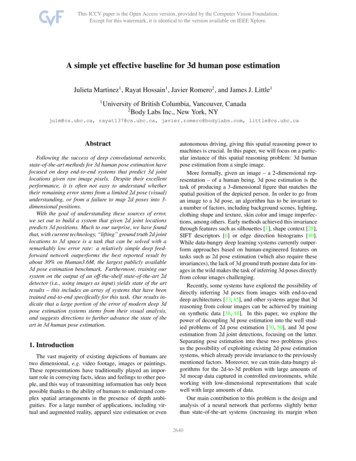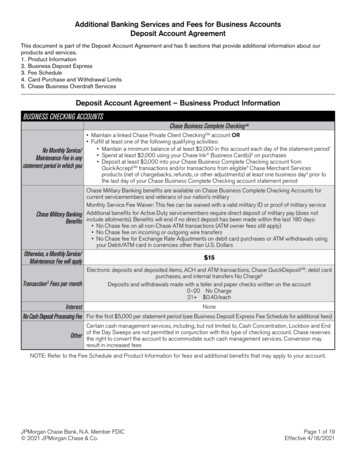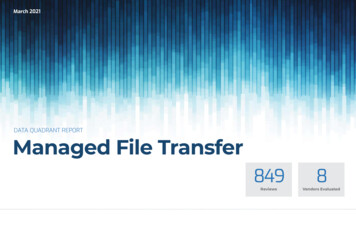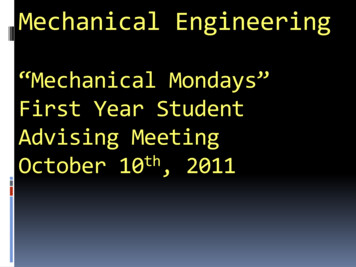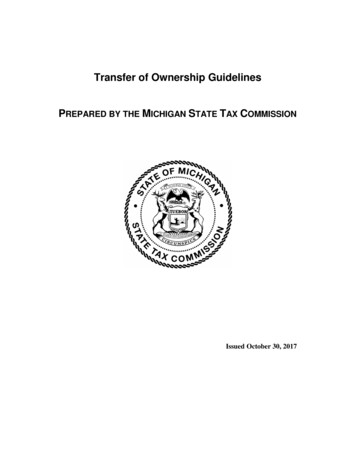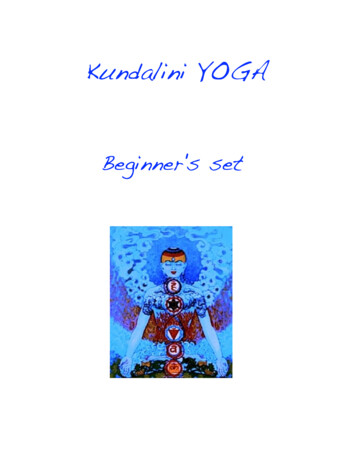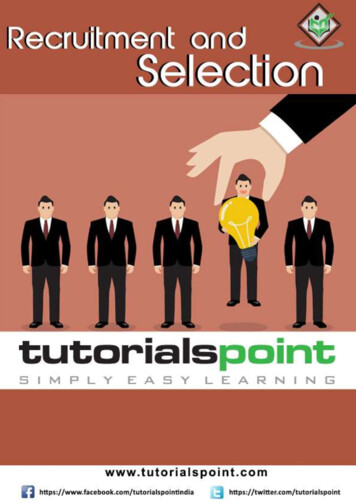
Transcription
Pose2Pose: Pose Selection and Transfer for 2D CharacterAnimationNora S WillettHijung Valentina ShinZeyu JinPrinceton UniversityPixar Animation StudiosAdobe ResearchAdobe ResearchWilmot LiAdam FinkelsteinAdobe ResearchPrinceton UniversityFigure 1: An example of selecting poses and transfering them to a 2D character. From an input video, we track the performer’s posesand cluster them. With our UI, an artist selects pose clusters and uses those clusters as reference for creating a character. Then, ouralgorithm automatically drives an animation using pose data from a new performance video.ABSTRACTAn artist faces two challenges when creating a 2D animated character to mimic a specific human performance. First, the artist mustdesign and draw a collection of artwork depicting portions of thecharacter in a suitable set of poses, for example arm and hand posesthat can be selected and combined to express the range of gesturestypical for that person. Next, to depict a specific performance, theartist must select and position the appropriate set of artwork at eachmoment of the animation. This paper presents a system that addresses these challenges by leveraging video of the target humanperformer. Our system tracks arm and hand poses in an examplevideo of the target. The UI displays clusters of these poses to helpartists select representative poses that capture the actor’s style andpersonality. From this mapping of pose data to character artwork, oursystem can generate an animation from a new performance video. Itrelies on a dynamic programming algorithm to optimize for smoothanimations that match the poses found in the video. Artists usedour system to create four 2D characters and were pleased with thePermission to make digital or hard copies of all or part of this work for personal orclassroom use is granted without fee provided that copies are not made or distributedfor profit or commercial advantage and that copies bear this notice and the full citationon the first page. Copyrights for components of this work owned by others than theauthor(s) must be honored. Abstracting with credit is permitted. To copy otherwise, orrepublish, to post on servers or to redistribute to lists, requires prior specific permissionand/or a fee. Request permissions from permissions@acm.org.IUI ’20, March 17–20, 2020, Cagliari, Italy 2020 Copyright held by the owner/author(s). Publication rights licensed to ACM.ACM ISBN 978-1-4503-7118-6/20/03. . . 15.00https://doi.org/10.1145/3377325.3377505final automatically animated results. We also describe additionalapplications addressing audio-driven or text-based animations.CCS CONCEPTS Human-centered computing Gestural input; Systemsand tools for interaction design.KEYWORDSPose selection; animation; 2D character creation.ACM Reference Format:Nora S Willett, Hijung Valentina Shin, Zeyu Jin, Wilmot Li, and AdamFinkelstein. 2020. Pose2Pose: Pose Selection and Transfer for 2D CharacterAnimation. In 25th International Conference on Intelligent User Interfaces(IUI ’20), March 17–20, 2020, Cagliari, Italy. ACM, New York, NY, USA,12 pages. ONDesigning the motion of 2D or 3D characters is a critical part ofcreating animated stories. Relative to traditional keyframe-basedworkflows, performed animation provides a more convenient wayto specify how characters move. Instead of authoring individualframes or specifying motion curves, an actor simply demonstratesthe desired movements, which are acquired via video or motioncapture [36] and transferred to the character. For most 3D characters, the motion transfer is relatively straight forward. Each joint onthe actor typically corresponds to a matching joint on the character,which allows the continuous motion of the performer to be mappeddirectly to the 3D character producing convincing, nuanced animations. As a result, performance animation is used for a wide range
IUI ’20, March 17–20, 2020, Cagliari, Italyof 3D animation scenarios, from feature films to games to specialeffects.In contrast to 3D animation, this paper focuses on a 2D styletraditionally called “cutout animation.” Characters are representedby layered artwork that is animated through a combination of bothcontinuous deformations (e.g. an arm bending at the elbow) anddiscrete transitions (e.g. a finger point replaced with a thumbs-up,or an open arm pose replaced with crossed arms) [66]. This style isprevalent in popular TV shows, such as South Park, The Late Show[19], Our Cartoon President [54], and streaming content like Twitch[47] and Final Space Live [28] that include animated avatars. Cutoutanimation has also been the subject of recent graphics and HCIresearch [60, 66–68]. While traditional cutout animation relies onkeyframes, newly emergent approaches use human performance todrive animations [19, 67]. Some existing performance-driven toolstransfer face/head motions to 2D characters [1, 10, 50, 68] or convertaudio input to mouth animations [18].However, no prior 2D animation system supports automatic triggering of arm/hand poses through human performance which significantly increases the expressiveness of performance-driven 2Danimation. Directly applying performance animation to 2D characters is more challenging than the 3D case because of a mismatchbetween the degrees of freedom of the actor and character. While thecontinuous motion of an actor can theoretically be projected into 2Dand then mapped directly to continuous deformations of the relevantlayers, such deformations produce awkward results for all but thesmallest changes in pose. These continuous 2D deformations canproduce subtle movements, as shown in our results and [22, 46], butmany pose transitions involve larger changes such as a finger pointto thumbs up or crossing arms. As a result, when generating 2Danimations by hand, animators often combine continuous motionwith discrete artwork swaps that represent larger pose changes [52].Applying this technique in a 2D performance animation workflowinvolves two key challenges: 1) at character design time, the artistmust select (and draw) a representative set of poses that cover thedesired range of motions for the character; and 2) at animation time,the system must carefully time the discrete transitions between therepresentative poses based on the movements of the actor.To address these challenges, we propose a new approach to 2Dperformance animation that facilitates the design and animation of2D characters from reference videos (Figure 1). We start with atraining video of an actor demonstrating the personality and typicalmovements of the character. From this video, we analyze the actor’sposes and provide a pose selection interface that helps an artistbrowse and select a set of representative poses to draw. Finally,given a 2D character with representative poses and a performancevideo where the actor demonstrates the desired character motion, oursystem automatically generates an animation that transitions betweenthe appropriate poses via dynamic programming. Since hand andarm motions are often the most expressive aspects a performance,our current implementation supports the transfer of upper bodymovements to 2D characters.An important element of our approach is the use of a trainingvideo during the character design process. Not only does this videohelp artists select representative poses to draw, it also allows oursystem to acquire a mapping from the drawn poses to a set of corresponding tracked poses from the training video. We leverage thisWillett, et al.mapping to automatically trigger pose transitions based on newperformances and to add subtle continuous motion to the resultinganimations based on the pose variations in the training video.To evaluate our approach, we recruited four artists to designand animate 2D characters using our system. All of the animationexamples in our submission were generated based on their designs.We collected qualitative feedback on their experiences, and theirresponses indicate that our pose selection interface helped themunderstand the variety of movements in the training video and decidewhat representative poses to draw. In addition, we evaluated thequality of our synthesized animations against manually-authoredresults created by a professional 2D animator and the output of twovariations of our animation algorithm. Finally, we demonstrate twoadditional applications that our approach supports: audio-driven andtext-based animation.2RELATED WORKPrior work focuses on 3D and 2D performed animations as well ascreating 2D characters.3D Performed Animation: Many existing techniques have beenproposed for generating 3D animation from performances. The mostcommon method is through motion capture [36] to control all partsof the character. In addition, researchers have explored other waysto synthesize character motion, through analyzing and classifyingperformed gestures [49], directly sketching limb movements [57],and generating gestures from audio features [5, 13, 29, 30, 32, 41,58] and text [8]. Our work focuses on animating 2D drawn charactersrather than 3D models. Hence, we require different techniques formapping human performances to animation.2D Performed Animation: Prior work in 2D performed animation presents several different techniques for controlling 2D artwork.One simple example is mapping the mouth of 2D characters to ahand opening and closing creating a new version of a sock puppetwith the mixed reality app YoPuppet [23]. Another way is to manually trigger artwork during a performance [67]. Numerous systems[1, 10, 50] and previous research [18, 68] focus on automatic headand mouth animations. Template-based deformation systems allowfor full body movement but are limited to small deformations of theoriginal template and can not handle larger changes in appearancesuch as an open hand to a closed fist [22, 46, 53]. In addition, thereare a variety of methods to animate 2D characters through othertechniques [3, 25, 26, 59]. In contrast, we are interested in handlinglarge pose changes while automatically animating a 2D characterfrom an upper body performance.2D Character Creation: Our 2D characters consist of a multilayer representation that defines the relationships between layers.This representation has been used in previous research and commercial 2D animation systems, including [66] and [1]. In most workflows, artists design and create layered 2D characters by drawingfrom scratch [20] or by reusing existing static images. Fan et al.enable the creation of 2D layered characters from multiple still images of the character [11]. In contrast, we provide a user interfacethat leverages an input video to assist artists with the creation ofanimated characters.
Pose2Pose: Pose Selection and Transfer for 2D Character AnimationIUI ’20, March 17–20, 2020, Cagliari, ItalyFigure 2: Caricatures of Donald Trump from 2D animations. (a) Cartoon Trump giving the State of the Union address. [34]. (b)Cartoon Trump participating in the GOP debates [9]. (c) Cartoon Trump at a rally [62]. (d) Cartoon Trump watching TV [38].3CHALLENGESAnimating a 2D character through performance involves multiplechallenges at different stages of the process.Capturing Performances: The first challenge is how to captureperformances. Most motion capture systems require specializedhardware, like UV cameras and tracking markers, that may be inaccessible or inconvenient for many artists. As a result, we recordperformances with monocular video and extract the pose of theperformer through markerless, vision-based pose tracking. This approach enables artists to easily capture performances using standardsmart phones and digital cameras, or to leverage the plethora ofvideos on streaming platforms such as YouTube.Designing Characters: Another challenge for the artist is howto encapsulate the personality of a character. When caricaturing aperson for an animation, artistic visions vary widely. Every artistchooses different aspects of the character to emphasize. For instancein Figure 2, some artists emphasize Trump’s hair (b,d), other’s hismouth (c,d) or hands (a). Even with similar poses, such as the armsopen, artists will interpret it differently (Figure 2a,b,c). While thedesign of a character’s appearance is part of our workflow to createa character, we leave the style to the discretion of the artists.Instead, the challenge that we focus on is the selection of a character’s poses that best emphasize the artist’s message. Identifying akey set of poses to draw is hard since the poses must be expressiveenough to cover a range of scenarios and emotions. However, drawing these poses is labor intensive, so we want the set to be minimalas well. In addition, if the character is modeled after a performer,the artist may have to carefully watch the performer for some timeto capture the right set of poses. Choosing a representative set ofposes for an animated character is a subjective process motivated bythe aesthetics and creative goals of the artist. Thus, while previouswork on automatic pose selection [2] could provide alternatives toour specific pose clustering technique, our main goal is to design aninteractive system that assists artists in the selection process. Oursystem addresses these problems by proposing a pose-centered videobrowsing interface that helps artists identify common poses in theinput video. In principle, the artist could select poses simply bywatching the videos linearly and marking specific frames, instead ofusing our clustering based interface. However, this manual workflowwould be cumbersome given that the input videos in our experimentsranged from 26 to 49 minutes long and included extended periodswhere the actor was not visible. Moreover, even after finding therelevant parts of the footage, the artist may still need to re-watchsections to determine the most typical and distinct poses.Generating Animations: When animating, another challengeis how to transfer human motion to a character. In the 3D world,Figure 3: System pipeline. (a) The artist obtains an input training video. (b) Acquire pose tracking data from OpenPose [21]. (c)Process the frame pose data into frame groups. (d) Cluster the poses. (e) The artist selects some pose clusters. (f) The artist designs acharacter with the selected poses. (g) The artist finds another character input video of which parts will be animated. (h) Use Openposeon the new video. (i) Process the frames into frame groups. (j) Segment the video into smaller result parts. (k) Assign frames from thesegments to one of the artist selected pose clusters based on the pose data. (l) Animate the final character.
IUI ’20, March 17–20, 2020, Cagliari, Italymotion capture is easily mapped to a 3D character model becausehuman joints and their movement are directly transferable to thejoints on the humanoid 3D character. However, when transferringthe continuous input of joint movements to the discrete output ofdisplaying a 2D artwork layer, there is more ambiguity due to acharacter’s design.For example, during the design process, an artist draws a characterwith a pose of wide open arms and hands. In addition, they drawartwork for clasping hands together showing the backs of the character’s forearms with fingers intertwined. When animating, a human’spose of wide open arms and hands can be directly mapped to thecharacter’s first pose. With slight human movement, the 2D character can copy the movement through deformations. For instance, thehuman flaps their arms and the character’s arms deform up and downas well. However, if the actor suddenly brings their hands down andclasps them, the question becomes at what point during the humanmovement do the separate artwork layers transition. In addition, theartist only draws artwork for a subset of all possible human movement. So then, we must determine which piece of artwork to switchto in order to best approximate the current human pose.4WORKFLOWTo address these challenges, we propose a new approach for designing and animating 2D characters (Figure 3). In the description below,we refer to the person designing the character as an artist, and theperson animating the character as an actor or performer. While itis possible for the same user to carry out both of these tasks, wedistinguish the roles to clarify the different stages of our proposedworfklow.4.1Designing CharactersThe artist starts by obtaining a training video of a human performerdemonstrating the range of poses for the character (Figure 3a). Thisvideo may be created by the actor who will eventually drive thefinal animation, or if the goal is to create an animated version ofa celebrity, it may be possible to find existing recordings to usefor training. To facilitate pose tracking, the performer in the videoshould mainly be facing the camera with their hands in full view asmuch as possible.Next, the artist uses our pose selection interface to identify representative poses for the character based on the training video. Afterloading the video into our system, the artist sees a set of candidate poses extracted from the video (Figure 3e and 4). The systemcategorizes poses based on which hands are visible (Both Hands,Left Hand, or Right Hand) to help artists quickly browse relatedposes. In addition, since every pose generally corresponds to severalframes in the video (i.e., poses represent clusters of similar videoframes), our interface sorts the poses based on the cluster sizes, sothat common poses are easy to identify. For each pose, the systemshows a visualization of the extracted joint positions from up to 50frames within the cluster and a looping sequence of actual videoframes (represented as an animated gif) that map to the same pose.To explore a candidate pose in more detail, the artists clicks theDetails button to see a new page showing gifs of several differentvideo frame sequences associated with the pose, sorted based ontheir similarity to the “average” pose within the cluster.Willett, et al.Using this interface, the artist selects the desired number of representative poses for the character. By categorizing, sorting andvisualizing poses as described above, our interface helps users focuson promising candidate poses without examining every individualpose cluster. However, the artist still ultimately has the freedom topick whichever poses they decide will best capture the character theyare designing. For most animations, it is useful to have a designatedrest pose that the character returns to whenever the performer isnot explicitly striking a pose. By default, the system labels the firstselected pose as the rest pose, but the artist can override this choice.Finally, after selecting representative poses, the artist creates adrawing for each pose cluster (Figure 3f). Our system associatesthese drawings with the corresponding poses.4.2Generating AnimationsGenerating a new animation of the 2D character requires a performance video where a human actor demonstrates the desired performance (Figure 3g). This video can either be recorded by the actoror obtained from existing footage, just like the training video. Oursystem automatically synthesizes an animation that moves throughthe representative poses based on the recorded performance (Figure 3k). While we create a simplified stick figure previz version ofthe animation (Figure 3k), the most compelling results are createdby artists (Figure 3l and 9).5METHODSOur approach includes automated algorithms for extracting pose data,clustering similar poses, and generating pose-to-pose animations.Here, we describe these methods and explain how they support theproposed workflow.Figure 4: The user interface for selecting clusters. Top, the clusters selected by the artist. Bottom, all the pose clusters separated by hand type.
Pose2Pose: Pose Selection and Transfer for 2D Character Animation5.1IUI ’20, March 17–20, 2020, Cagliari, ItalyExtracting PosesOur pose selection interface and performance-driven animation technique require analyzing the pose of a human actor in training andperformance videos. Recent work on pose estimation from monocular video suggests that neural networks can be very effective forthis task [7, 12, 37, 42]. We use the open source library of OpenPose[21], based on the publications of Simon et al. [55] and Wei et al.[65], to extract pose information for each video frame (Figure 3b).Since we focus on upper body performances, we only consider the(x, y) coordinates and confidence scores for the hand, arm and neckjoints.5.2Processing PosesGiven that poses in consecutive frames are typically very similar,we segment videos into frame groups that represent distinct poses(Figure 3c). Operating on frame groups significantly reduces thecomputational cost of the clustering and frame assignment algorithms described below.As a first step, we filter out frames with either no detected peopleor more than two people. For each frame containing one to twopeople, we select the one whose bounding box centroid is closestto the center of the image as the primary subject. We then computea feature vector that encodes the upper body pose of the primarysubject. The dimensionality of the vector depends on the number ofhands that are visible in the frame (i.e., 75% of the hand jointsare within the image bounds). If both hands are visible and three ormore finger tip joints on each hand are detected with high confidence(greater than 1%) the frame is a Both Hands pose. If there are threeor more high confidence finger tips for only one visible hand, theframe is either a Left Hand or Right Hand pose. Otherwise, welabel the frame as having No Hands. As noted earlier, our poseselection interface organizes the training video into these pose typesto facilitate browsing.We compute a pose feature vector for all Both Hands, Left Hand,and Right Hand frames. The feature vector includes the (x, y) valuesof each wrist joint relative to the neck joint and the distance fromeach finger tip to the corresponding wrist joint. The wrist positionscapture gross arm movements, and the finger distances encode finegrained information about the hand shape. We also experimentedwith other feature vectors that included individual finger joint angles,but these suffered from unreliable joint data, projection ambiguities,and the curse of dimensionality (i.e., too many degrees of freedom).We found that finger distances provided a compact representationwith sufficient expressive power to distinguish between differenthand poses.Next, we normalize the feature vectors to account for camerachanges or cuts that make the person bigger or smaller in relation tothe frame. We estimate the scale of the subject in each frame by computing the inter-shoulder pixel distance relative to the frame diagonaland construct a histogram based on this measure, which representsthe distribution of such scales across the video. To reduce noise, wesmooth the distribution with a Gaussian filter (σ 5px), as shownin Figure 5. Then, we identify sets of frames with approximatelythe same subject scale by splitting the histogram into sections withboundaries at the local minima of the smoothed counts. For eachsection, we compute a normalization factor by taking the medianFigure 5: A histogram of shoulder pixel distances relative to theframe diagonal for normalizing the feature vectors. All frameswith good hand data were counted. The red line is the smootheddistribution used to split the counts into sections. There is a camera shift represented by the gap of distances between 0.21 and0.25.inter-shoulder distance and dividing it by the median distance for theentire video. We then normalize the feature vector for each framewith the corresponding normalization factor. Sections that have verylow counts ( 1% of all frames) typically arise from quick zoomsor cuts to different people or the subject turning to the side. We treatthese as outliers and label them as No Hands poses.Once the feature vectors are computed and normalized, we splitthe frames into frame groups, which are consecutive frames thatrepresent a pose. To construct these groups, we visit each frame inorder, adding it to the current frame group until either the hand typechanges or the Euclidean distance between the current pose featurevector and the first one in the frame group is greater than a thresholdof 60. If either of these conditions are met, we start a new group. Weuse the feature vector of the middle frame to represent each framegroup.5.3Clustering PosesOur pose selection interface presents artists with candidate poses thatcover the range of motions in the training video. To compute thesecandidates, we cluster the pose feature vectors of all frame groupsfor each hand type into sets of similar poses (Figure 3d). We notethat the notion of “similar” here is not well-defined. For instance,should a pose with open fingers and open straight arms be groupedwith closed fists and open straight arms? Or should the closed fistsand open straight arms be grouped instead with closed fists andslightly bent arms? Depending on the scenario, either grouping maybe preferred. Since there is no one correct answer, our goal is toprovide a reasonable clustering to help artists select representativeposes when designing a character.To this end, we experimented with various clustering methods(DBSCAN, MeanShift and Affinity Propagation) using a range of parameters and visualized the results using t-SNE [31]. We restrictedour exploration to techniques that adaptively determine the totalnumber of clusters. In the end, we found that sklearn’s Affinity Propagation [17] (with damping set to 0.51) provided the best balancebetween too few and too many clusters. Figure 6 shows example
IUI ’20, March 17–20, 2020, Cagliari, Italyclusters and some of the frame groups they contain. For our results,we had 150 to 300 clusters per character.5.4Mapping Performance to AnimationTo generate an animation from a given performance video (Figure 3g), our system automatically maps the video frames to therepresentative poses of the character (Figure 3k). In addition, weintroduce a simple technique to add subtle continuous motion to theanimation based on the pose variations from the input training video.5.4.1 Frame Assignment. As a first step, our system processesthe performance video in the same manner as the training video toextract frame groups (Figure 3h,i). We then map the sequence offrame groups to a sequence of representative character poses viadynamic programming [4] (Figure 3k).Assignment Energy: Our optimization solves for an assignment{a1 , a2 , . . . , an } where n is the number of frame groups in theperformance video, and ai is the assigned pose cluster for framegroup i that minimizes the following energy:E({a1 , a2 , . . . , an }) m nXkL · EL (a j ) kP · EP (a j )j 1where a j is the jth contiguous run of frame groups with the sameheld pose assignment, which we refer to as a segment; m is thenumber of segments; EL is a length energy that prevents each segment from being too short; EP is a pose energy that measures thesimilarity of an assigned pose to the set of tracked poses in the corresponding frame groups; and (kL , kP ) are weights that trade off theimportance of the two energy terms.Length Energy: The length energy applies a quadratic drop offto penalize segments that are shorter than a threshold ϕL : 2 (3nj ϕL ) if nj max(cL , ϕL )ϕLEL (a j ) 0,otherwiseFigure 6: Three clusters (above) and three example framegroups from each cluster (below).Willett, et al.where nj is the total number of frames in the segment, and cL is theaverage length of all the training frame groups in the correspondingpose cluster.Pose Energy: We define the pose energy of a segment asEP (a j ) njXd(p(a j ), pj,i )i 0where pj,i is the extracted pose from the ith video frame of the jthsegment in the assignment; p(a j ) is the pose closest to the assignedcluster’s centroid; and d(p1 , p2 ) is the distance between two poses.We compute this pose distance based on the hand types for the twoposes. If they match, then we use the Euclidean distance betweenthe feature vectors. If they do not match, we set the pose distanceto a constant kD . If the ith video frame does not have a pose (nopeople or hands in the frame), then we use the Euclidean distancebetween the assigned pose cluster and the rest pose cluster.Constants: Our frame assignment algorithm includes constants(kL , kP , kD , ϕL ) that control the relative strengths of the energies,how likely a pose is to switch to a different hand type, and howshort segments should be. As we discuss in the Evaluation section,we searched over a range of potential parameter values and foundthat defaults of kL 2, kP 1, kD 0.7, ϕL 15 generallyproduced the best results.5.4.2 Continuous Movement. The optimization above generates a sequence of character poses based on the performance video.To increase the expressiveness of the resulting animation, we addcontinuous movement to the character’s hands for each held pose.First, we determine the range of hand motions within a clusterfrom the training video poses that correspond to each held characterpose. More specifically, we align all the cluster poses spatially basedon the position of the neck joint so that they occupy a shared spaceand then compute the convex hull of the wrist joint positions (Figure 7). Then, we generate a randomized motion path for each handby constructing a Bezier curve inside the convex hull. Starting atthe wrist position for the center frame of the cluster, we add Beziercontrol points one at a time by translating along a randomly varyingvector. At each iteration, we rotate the vector by a random anglebetween -90 and 90 degrees and scale the vector by a sine functionwhose amplitude is between 50% and 175% of the square root of theconvex hull’s area. If the resulting vector moves the control pointoutside the convex hull, we construct a new r
in Figure 2, some artists emphasize Trump’s hair (b,d), other’s his mouth (c,d) or hands (a). Even with similar poses, such as the arms open, artists will interpret it differently (Figure 2a,b,c). While the design of a character’s appearance is part of our workflow to create a character, we leave the
